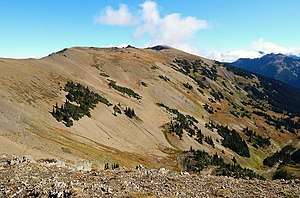Elk Mountain (Clallam County, Washington)
Elk Mountain is a 6,773 feet (2,064 m) summit located in the Olympic Mountains, in Clallam County of Washington state.[2] It is set within Olympic National Park and is situated at the eastern end of Hurricane Ridge. Its nearest higher peak is McCartney Peak, 5.12 mi (8.24 km) to the south-southwest.[1] Precipitation runoff from the south slope of the mountain drains into tributaries of the Dungeness River, whereas the north slope is drained by tributaries of Morse Creek which thence empties into the Strait of Juan de Fuca.
| Elk Mountain | |
|---|---|
 Elk Mountain seen from Obstruction Peak | |
| Highest point | |
| Elevation | 6,773 ft (2,064 m) [1] |
| Prominence | 813 ft (248 m) [1] |
| Coordinates | 47°55′29″N 123°21′07″W [1] |
| Geography | |
 Elk Mountain Location of Elk Mountain in Washington  Elk Mountain Elk Mountain (the United States) | |
| Location | Olympic National Park Clallam County, Washington, United States |
| Parent range | Olympic Mountains |
| Topo map | USGS Maiden Peak |
| Geology | |
| Age of rock | Eocene |
| Type of rock | Shale |
| Climbing | |
| Easiest route | Hiking Trail |
Olympic National Park is home to the largest unmanaged herd of Roosevelt elk in the Pacific Northwest.[3] Named after President Theodore Roosevelt, they are North America's largest variety of elk. It is ironic that none are now found in the area of Elk Mountain. As for the mountain's name origin: According to a 1984 field guide:[4]
There is a story told that in 1890, William Wooding, a local homesteader, along with some friends, slaughtered 15-20 elk at this spot, leaving their carcasses to decay in the woods. Upon returning to civilization, Wooding made the mistake of bragging about the episode. He and his friends were promptly ordered by the authorities to return to the site and carry out the dead elk.
Climate
Set in the north-central portion of the Olympic Mountains, Elk Mountain is located in the marine west coast climate zone of western North America.[5] Most weather fronts originate in the Pacific Ocean, and travel northeast toward the Olympic Mountains. As fronts approach, they are forced upward by the peaks of the Olympic Range, causing them to drop their moisture in the form of rain or snowfall (Orographic lift). As a result, the Olympics experience high precipitation, especially during the winter months in the form of snowfall. During winter months, weather is usually cloudy, but, due to high pressure systems over the Pacific Ocean that intensify during summer months, there is often little or no cloud cover during the summer. Because of maritime influence, snow tends to be wet and heavy, resulting in avalanche danger.
Geology
The Olympic Mountains are composed of obducted clastic wedge material and oceanic crust, primarily Eocene sandstone, turbidite, and basaltic oceanic crust.[6] The mountains were sculpted during the Pleistocene era by erosion and glaciers advancing and retreating multiple times.
References
- "Elk Mountain, Washington". Peakbagger.com.
- "Elk Mountain". Geographic Names Information System. United States Geological Survey. Retrieved 2019-10-08.
- National Park Service
- Parratt, Smitty (1984). Gods and Goblins: A Field Guide to Place Names of Olympic National Park (1st ed.).
- McNulty, Tim (2009). Olympic National Park: A Natural History. Seattle, Washington: University of Washington Press.
- Alt, D.D.; Hyndman, D.W. (1984). Roadside Geology of Washington. pp. 249–259. ISBN 0-87842-160-2.
External links
- Weather forecast: Elk Mountain
- "Olympic National Park". National Park Service.
- YouTube: Elk Mountain